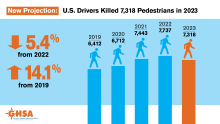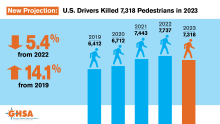Concern has been expressed at the high number of fatalities involving motorcycle users in the US during 2015. Preliminary figures from state authorities show that over 5,000 people were killed in motorcycle crashes in the US over the course of 2015. The full data has yet to be compiled and analysed but these early figures suggest an increase in motorcyclist deaths of 10% for 2014 compared with 2015, or around 450 more people killed than in the year previously.
The report was released as part of the Gove
Concern has been expressed at the high number of fatalities involving motorcycle users in the US during 2015. Preliminary figures from state authorities show that over 5,000 people were killed in motorcycle crashes in the US over the course of 2015. The full data has yet to be compiled and analysed but these early figures suggest an increase in motorcyclist deaths of 10% for 2014 compared with 2015, or around 450 more people killed than in the year previously.
The report was released as part of the Governors Highway Safety Association’s (GHSA) annual forecast of motorcyclist fatalities. There is concern too as this comes as warm weather will encourage many to take to the road on motorcycles either for the first time, or after taking their motorcycles out of storage following winter.
The Motorcyclist Traffic Fatalities by State: 2015 Preliminary Data report is the GHSA’s sixth annual analysis of motorcyclist deaths in the form of a Spotlight report. The series provides an early look at current data, trends, and developing issues. Worryingly the GHSA projects the final motorcyclist fatality total for 2015 will be 5,010 – only the third year in US history and the first time since 2008 in which the fatality number topped 5,000.
All 50 states and the District of Columbia contributed their preliminary motorcyclist fatality counts for the full 2015 calendar year for this latest report. Compared with 2014, motorcyclist fatalities increased in 31 states, decreased in 16 states, and remained the same in three states plus the District of Columbia. The report was authored by Richard Retting and Heather Rothenberg of Sam Schwartz Consulting.
According to Retting, “These sobering findings provide a stark reminder of how susceptible motorcyclists are to fatal and life-threatening injuries. The risk of motorcycle crashes and fatalities is compounded by factors such as alcohol and drug use, increased speed limits, the repeal of state helmet laws, and a record number of vehicles on US roads. Concerted efforts are needed to reduce this tragic loss of life.”
It is widely known that the one single measure that would cut motorcyclist deaths in the US would be to restore the requirement to wear a helmet in all US states. At present 31 states lack such measures. Even in states with helmet use laws, not all specify that helmets must comply with2364 US Department of Transportation standards. This additional requirement could also improve enforceability of helmet laws and the level of protection offered by helmets.
Currently, only 19 states and DC require all riders be helmeted. Another 28 mandate helmet use by riders younger than age 18 or 21, and three have no requirement. According to a 2014 National Highway Traffic Safety Administration (NHTSA) study, the use rate of helmets in universal law states was 89%, compared with 48% in all other states.
GHSA executive director Jonathan Adkins commented, “State and national data illustrate that motorcyclists are far more likely to be injured or killed in a crash than motor vehicle occupants. GHSA and its members will continue to support the development, implementation, and evaluation of evidence-based motorcycle safety countermeasures to improve rider safety and, ultimately, save lives.”
The GSHA advises that motorcyclists can take actions to reduce the risk of being involved in a fatal crash. Key factors include always wearing a DOT-compliant helmet, even when not required by state law, wearing bright-coloured clothing to make it easier to be seen by other road users, never riding impaired by alcohol or other drugs and obeying posted speed limits.
When purchasing a new motorcycle, the GSHA advises opting for a model with antilock brakes, as these have been shown to decrease fatal motorcycle crashes. Meanwhile drivers of other motor vehicles should always be aware and looking out for motorcyclists around them and, of course, obey all traffic laws.
The report was released as part of the Governors Highway Safety Association’s (GHSA) annual forecast of motorcyclist fatalities. There is concern too as this comes as warm weather will encourage many to take to the road on motorcycles either for the first time, or after taking their motorcycles out of storage following winter.
The Motorcyclist Traffic Fatalities by State: 2015 Preliminary Data report is the GHSA’s sixth annual analysis of motorcyclist deaths in the form of a Spotlight report. The series provides an early look at current data, trends, and developing issues. Worryingly the GHSA projects the final motorcyclist fatality total for 2015 will be 5,010 – only the third year in US history and the first time since 2008 in which the fatality number topped 5,000.
All 50 states and the District of Columbia contributed their preliminary motorcyclist fatality counts for the full 2015 calendar year for this latest report. Compared with 2014, motorcyclist fatalities increased in 31 states, decreased in 16 states, and remained the same in three states plus the District of Columbia. The report was authored by Richard Retting and Heather Rothenberg of Sam Schwartz Consulting.
According to Retting, “These sobering findings provide a stark reminder of how susceptible motorcyclists are to fatal and life-threatening injuries. The risk of motorcycle crashes and fatalities is compounded by factors such as alcohol and drug use, increased speed limits, the repeal of state helmet laws, and a record number of vehicles on US roads. Concerted efforts are needed to reduce this tragic loss of life.”
It is widely known that the one single measure that would cut motorcyclist deaths in the US would be to restore the requirement to wear a helmet in all US states. At present 31 states lack such measures. Even in states with helmet use laws, not all specify that helmets must comply with
Currently, only 19 states and DC require all riders be helmeted. Another 28 mandate helmet use by riders younger than age 18 or 21, and three have no requirement. According to a 2014 National Highway Traffic Safety Administration (NHTSA) study, the use rate of helmets in universal law states was 89%, compared with 48% in all other states.
GHSA executive director Jonathan Adkins commented, “State and national data illustrate that motorcyclists are far more likely to be injured or killed in a crash than motor vehicle occupants. GHSA and its members will continue to support the development, implementation, and evaluation of evidence-based motorcycle safety countermeasures to improve rider safety and, ultimately, save lives.”
The GSHA advises that motorcyclists can take actions to reduce the risk of being involved in a fatal crash. Key factors include always wearing a DOT-compliant helmet, even when not required by state law, wearing bright-coloured clothing to make it easier to be seen by other road users, never riding impaired by alcohol or other drugs and obeying posted speed limits.
When purchasing a new motorcycle, the GSHA advises opting for a model with antilock brakes, as these have been shown to decrease fatal motorcycle crashes. Meanwhile drivers of other motor vehicles should always be aware and looking out for motorcyclists around them and, of course, obey all traffic laws.







